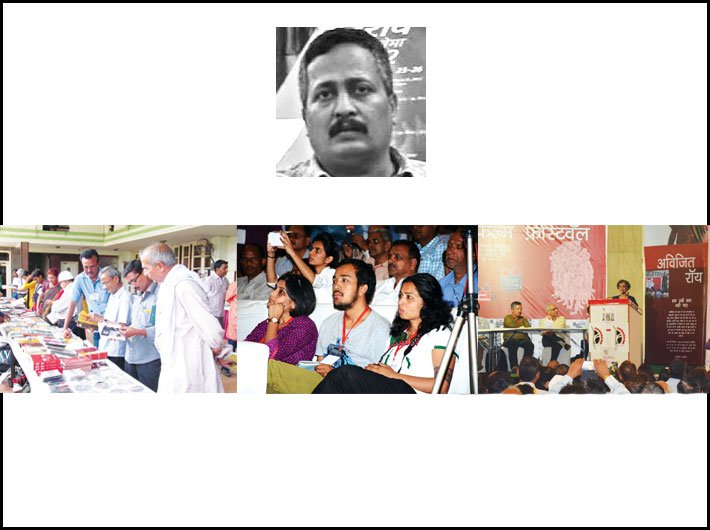Filmmaker Sanjay Joshi talks about the journey of Cinema of Resistance and the road ahead
In 2006, a group of cultural activists got together and collected contributions from the people of Gorakhpur to hold a film festival. It was quite different from regular film festivals as it refused corporate or government support or screen only those films which were politically correct. Soon, the initiative, called Cinema of Resistance (CoR), grew roots in more than 15 cities across the country. The festival, which has now become an annual affair, has entered in its 11th year in 2016.
The history of CoR goes back to 1985 when the Jan Sanskriti Manch (JSM) was formed under the leadership of radical Hindi poet Gorakh Pandey. JSM was not to be a collective of poets and writers alone, but a united platform that could accommodate diverse art forms like poetry, prose, theatre, cinema and music. Though efforts were made in the initial years, the culture of film screening never became popular. It was only after two decades that a major qualitative step was taken when cultural activists from the UP unit of JSM started formulating a new plan of taking cinema to the masses. Documentary filmmaker Sanjay Joshi got involved in this process and took central responsibility. And in 2006, Cinema of Resistance came into existence.
The films screened mainly highlighted social issues such as caste oppression, patriarchy, feudal system and impact of neoliberal policies, among others. In an interaction with Pankaj Srivastava, CoR’s national convener Sanjay Joshi talks about the movement’s journey, what differentiates it from other film festivals, the challenges, and the road ahead.
With the Gorakhpur film festival scheduled in May, Cinema of Resistance has entered 11th year. Why has such an initiative sustained for a decade?
I feel great that our initiative has successfully completed a decade. In my view, the main secret of success is our belief in people and not in corporates. Right from our very first film festival in 2006 in Gorakhpur, we have strictly followed the policy of not accepting big funding. This critical decision forced us to reach out to the people. That’s how in the last 10 years, we have managed to organise 54 film festivals in 15 cities. And with pride I can declare that in none of the festivals did we take any help from big corporations, rejecting lucrative offers from multinationals and major NGOs a number of times. Banking on people’s contribution has not only made such events possible in numerous towns but also spread the idea of people’s culture.
Can you tell us more about the idea of CoR and how you took it across the country?
Actually, in September 2005 while expanding the Jan Sanskriti Manch’s work in Uttar Pradesh, the idea of Cinema of Resistance or ‘Pratirodh Ka Cinema’ came into existence. In a meeting in Allahabad, the state body of the Manch initiated this idea of an independent, people’s film festival. It was very much clear in everybody’s mind that we had to develop this with the help of the common man only. Then in March 2006 we started the initiative with the first Gorakhpur film festival. By that time we already had digital technology. Thus, we easily acquired the content [in the form of films] and technology [LCD projectors] to screen the films. It is interesting to note that the idea of people’s contribution was not new; the Manch was practising this since its inception in 1985. The new thing was the introduction of cinema as a medium in north India. The first film festival in Gorakhpur was very well received and we got a great amount of publicity in local newspapers. The newly received publicity coupled with campaign on social media created a buzz about the organisation among general people. This led to the replication of Cinema of Resistance in Bhilai in 2007 and we also managed to sustain a second show in Gorakhpur the same year. Since 2008, the idea started growing rapidly and last year we organised 11 film festivals and managed to sustain 15 chapters.
We have always put emphasis on creating local centres and germinating the idea at the grassroot level. Thus, we try to start a local chapter and empower it with skills, resources and ideas, and with that carry forward the initiative through weekly or monthly screenings and annual festivals.
Tell us something about yourself and how you got hooked with this and not the lucrative Mumbai film industry?
Well, I’m trained in film-making from AJK Mass Communication Research Centre, Jamia Millia University. Before joining Jamia, I did my masters in Hindi literature from JNU where I was very much exposed to world cinema. After Jamia, in 1994, I started making films for different government and non-government organisations.
I’m excited with this initiative because I was very much influenced with the film society movement of Kerala. And especially by the Odessa experiment. The Odessa [an initiative for an independent film-making collective] was initiated by the great Malayali film-maker John Abraham. He tried to change both film-making and film screening practices. With one rupee contributions, he successfully produced India’s most important film, Amma Ariyan. So I knew that I can only make my kind of films if I have a new audience. Thus, I started taking interest in a Cinema of Resistance kind of idea. Now after 10 years, we have achieved a sustainable model for screening. I’m sure one day we will make our kind of cinema with the help from this new audience. That’s why I’m not struggling in Mumbai, rather making organic connection with people of Allahabad, Azamgarh, Banaras, Ballia, Bathinda, Maharajganj, Hyderabad, Kolkata, Bhilai, Ramnagar, Udaipur, Patna, and so on.
What kind of challenges are you facing today?
There are many challenges. Getting space for film screening is a big issue in north India. Yes, right-wing assertion is a major cause of concern because now they are not abiding the law. But in this age we have additional responsibility to reach new places with more vigour, power and intelligence. With our experience it is proven that demand for a CoR kind of initiative is growing day by day. I want to cite the interesting case of Nakul Singh Sawhney’s documentary Muzaffarnagar Baaqi Hai. The screening of the film in Delhi University’s Kirori Mal College in August 2015 was forcefully stopped by ABVP. In protest, CoR gave a nationwide call for screening the film. To our surprise, we successfully organised 90 screenings in 60 cities on August 25. This clearly shows the importance of a transparent, honest and intelligent people’s initiative. Yes, we need to prepare ourselves with much more concern and commitment.
What are the future plans of Cinema of Resistance?
With the continuous journey of ten years of CoR, it shows that the idea of people’s cinema is very much possible. Now we are planning to make it more intelligent and effective. We are also planning to make it possible at the grassroot level; till now we have focused only in cities. We need to take it to the village and mohalla level as well. One needs to viral this idea, only then can we give an effective resistance to rightist forces. We need to prepare many language-versions of important documentaries and feature films, and start campaigning against communalism, neoliberal policies and superstition. We are also planning to prepare ourselves for the online audience. The most important thing is to make meaningful cinema more accessible to common people and to connect them with the ongoing people’s struggle.
feedback@governancenow.com
(The interview appears in the April 1-15, 2016 issue)

